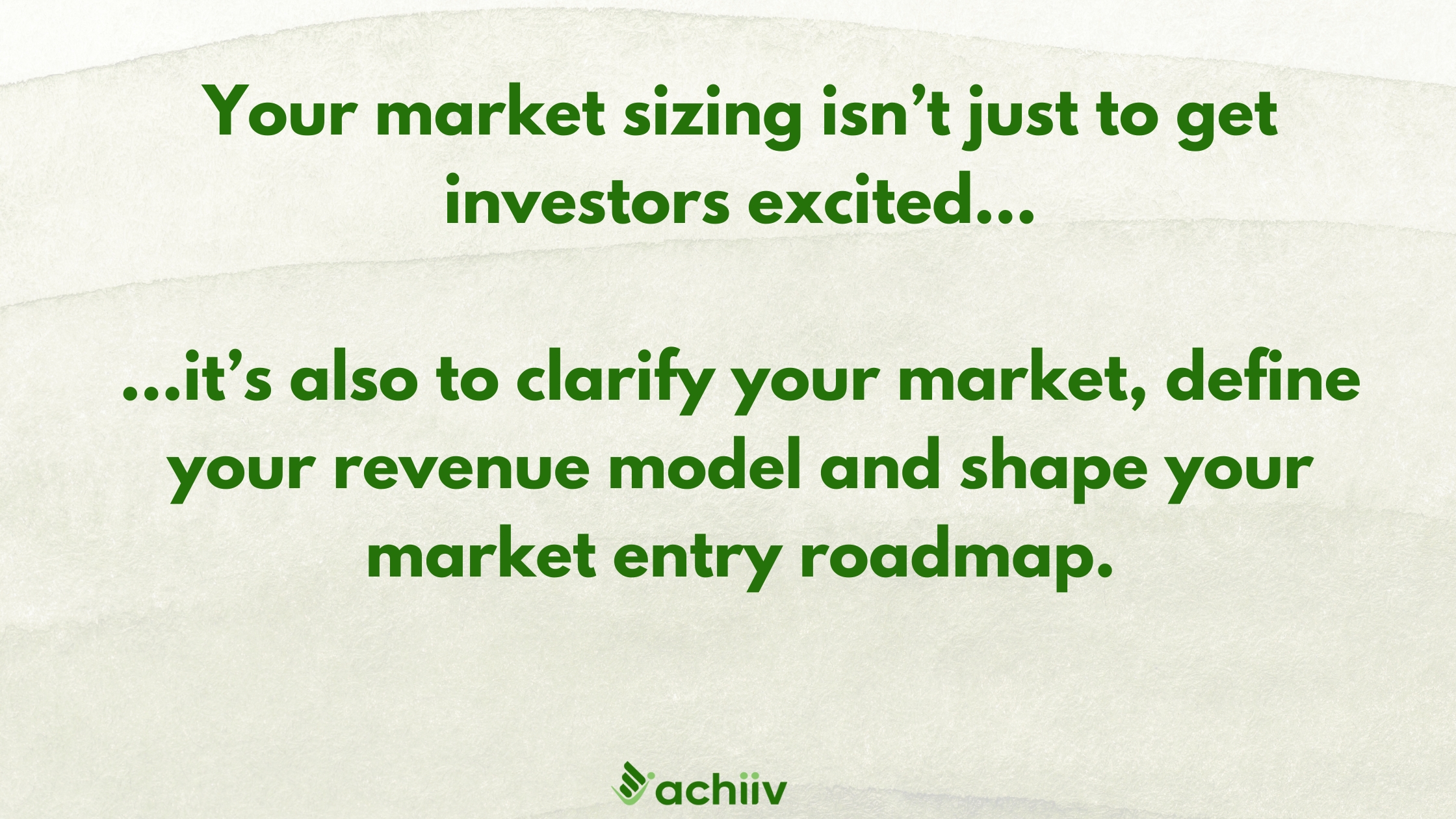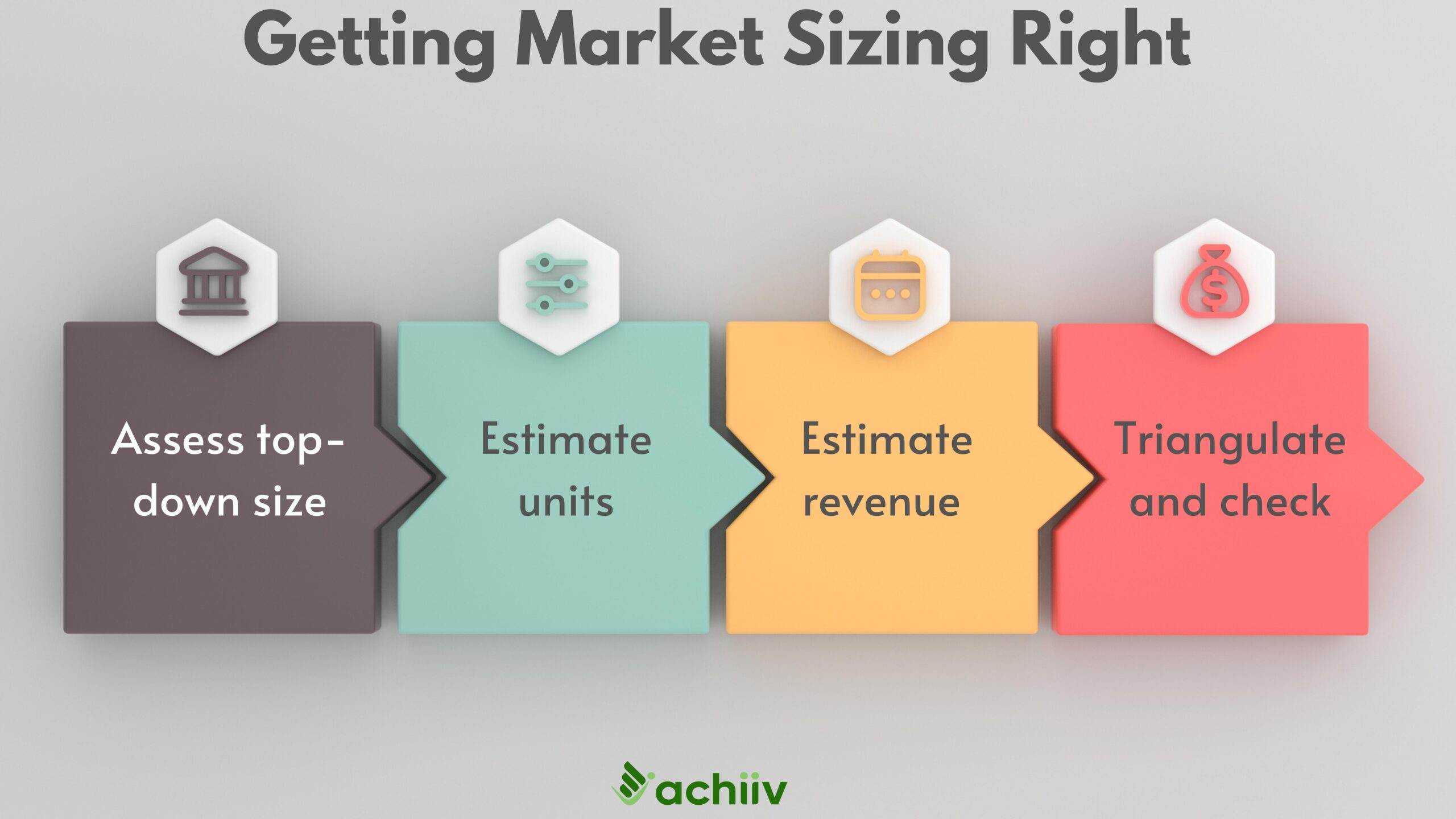The founder was building a platform that would help thousands of patients live better lives by helping them manage a complex jumble of treatments that created significant friction, frustration and confusion. Users loved the solution, and performance metrics were encouraging.
But her fundraising conversations were going nowhere. The stumbling block was obvious: a hugely inflated market size, in the tens of billions of dollars. For a niche product that only managed a medical condition, the number looked suspicious from the start. Just a little digging revealed that her market size included money spent on treating the condition, not just managing it. A more accurate sizing showed a market in the mere tens of millions – nowhere close to what would excite investors.
Too many founders cobble together a market size based solely on industry reports. They only focus on showing a big number with the three obligatory TAM (Total Addressable Market), SAM (Service Addressable Market) and SOM (Service Obtainable Market) “bubbles”, without applying any critical thinking to the exercise.
What this telegraphs to potential investors is:
- You don’t understand the market you’re tapping
- You don’t understand how to segment and approach that market effectively
- You have no credible basis for defining revenue potential and possible pricing
Supercharge Your Strategy
Your market sizing isn’t just a box for you to check in your pitch deck. It’s a canvas on which you can either paint a compelling opportunity that gets investors excited, or throw it away with a mindless splattering of paint communicating nothing of value.
A thoughtful market sizing exercise is also a powerful compass to guide your roadmap: you may even decide to change your funding strategy based on what it’s telling you.
There are three hidden ways good market sizing propels your startup:
Market Clarity: Who Are You Serving and What Are They Buying?
At its core, your market size is a function of how many units you could sell of your product, and the revenue potential of those units.
Calculating this number accurately means you have to define the ‘unit’ that drives your business. This feels like a simple act, but it will force you to define who your ideal customer is, and what their core value proposition is.
Are you selling software licenses or improved patient outcomes? Are you providing a service or a transformative experience? Each of these definitions carries different implications for your unit, as well as the price or revenue potential for that unit. To be able to do this well, you’ll need to thoroughly understand what constitutes value for your customer.
Our founder could define her unit as the number of patients served by the platform, the number of subscriptions by tier, the individual treatment management “products” sold to patients, or as a composite.
This wasn’t a trivial choice. Her decision had big downstream implications not only for her market sizing, but also for her pricing, how she defined the competition and how she differentiated herself from the industry.

Monetization Strategy: What Should You Charge For And How Much?
Your market size calculation inherently involves revenue. This prompts you to assess your pricing strategy and revenue model. What is value to your customer? How can that be integrated into a robust pricing and monetization strategy?
Say your company makes aircraft engines for planes. You know that the value of having good engines for your customers is highly dependent on how many hours they’re flown. Your customers also need to worry about maintenance for the life of the engine.
Understanding this may lead you to a completely different monetization method of charging by aircraft engine hours flown and including maintenance in the price, instead of just charging a flat price per engine delivered. You’ll have other benefits, because you’ll lock in a lifetime of maintenance revenue without having to renegotiate a contract every few years. This is in fact the exact approach that Pratt Whitney took with their aircraft engines.
Of course, monetization and pricing is a strategic decision YOU get to take as the founder, but you’ll see how this exercise opens up unexpected new horizons for your startup far beyond fundraising.
Market Access and Go-to-Market: Navigating the Landscape
The distinction between Total Addressable Market (TAM), Serviceable Addressable Market (SAM), and Serviceable Obtainable Market (SOM) forces you to think critically about market segmentation and your go-to-market strategy.
Which segments can you realistically reach? What channels will you use? The market sizing process helps refine these crucial aspects of your business plan.
Say you’re a clean energy startup with revolutionary solar panel technology. You might have a vast TAM. However, regulatory hurdles and established competitors might limit your SAM to just a few geographies and customer segments. To get a credible SOM estimate, you’ll also need to know which segments you’ll access first, through what channels, and for what revenues over a 5-7 year timeframe.
If you do this well, you’ll automatically improve the quality of your financial projections, making investors more inclined to take your pitch and projections more seriously. And all of this kicks in from almost the first page of your pitch.
Win Over Investors
A strong market sizing exercise sets you up for a great fundraising conversation with investors. It tells them that you have:
Financial Sophistication
Being able to articulate your estimation approach and back it up with credible data tells investors that you have a strong grasp of achievable results, that you deeply understand the link between strategy and financial results. You need this quantitative fluency to convince investors of your savvy.
Market Savvy
Your choice of market segmentation and the rationale behind TAM, SAM, and SOM are the receipts that prove your understanding of who your customers are, who else they might consider buying from, and how you’ll win them over. It signals that you’re not just chasing a dream but can start selling to potential customers from day one.
Strategic Clarity
A pitch where market size, business model and go-to-market strategy all line up tells your investors you know what not to do and what opportunities to not pursue as you go to market. Chasing red herring opportunities is a big risk for early stage startups: strong market clarity gives investors confidence that you’ll use your time and their money on the most productive avenues to drive sales and generate high quality revenue.

Make It Happen
To get credible market sizing, you need both a macro and micro-level approach:
- First establish a “one-step” market size using credible, macro-level industry data. Use widely respected and tested sources (e.g. Gartner), not one-off reports from dubious sources. But beware: Adjust industry estimate to match your category. Ensure numbers are apples-to-apples (e.g. market for healthcare project management software is NOT market for ALL project management software)
- Develop a micro-level approach: Develop justifiable estimates for how many customers / units could theoretically be sold in the ENTIRE market.
- Triangulate with multiple sources: Test the unit estimate against multiple sources such as industry reports, or even bottom up estimation
- Apply a reasonable revenue estimate per customer: Why is this supportable? How can you back it up with real and provable market or industry data?
Above all, be prepared to back up and prove every number.
Who knows – doing this exercise may give you completely fresh and unexpected insights into your market and startup path itself, AND put you in a great position to convince potential investors about the big payoff you can get for them.
Want more like this? Sign up now for Seed2Success from Achiiv – the weekly digest with insightful podcast episodes, financial storytelling advice, actionable tips and more – 100% free!







